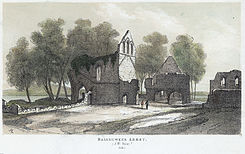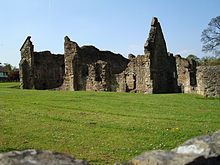Basingwerk Abbey
| Basingwerk Abbey | ||
|---|---|---|
Abaty Dinas Basing | ||
Year consecrated 1132 | | |
| Location | ||
| Location | Holywell, Flintshire, Wales | |
| Architecture | ||
| Type | Monastery | |
| Style | Cistercian | |
Basingwerk Abbey (
The site is now managed by Cadw – the national Welsh heritage agency.
Medieval history

The abbey was founded in 1132 by
In 1157, Owain Gwynedd encamped his army at Basingwerk, though at the Hen Blas site not at the current site,[5] before facing the forces of Henry II at the Battle of Ewloe. The Welsh Prince stopped at the abbey because of its strategic importance. It blocked the route Henry II had to take to reach Twthill, Rhuddlan. In the fighting that followed, Owain Gwynedd split his army routing the English near Ewloe.
The abbey had significant lands in the English county of Derbyshire. Henry II gave the monks a manor near Glossop. The Monks' Road and the Abbot's Chair near the town are a reminder of the Abbey's efforts to administer their possession. In 1290 the Abbey gained a market charter for Glossop.[6] The monks also got another charter for nearby Charlesworth in 1328.
By the 13th century, the abbey was under the patronage of
A legend says a 12th-century Basingwerk Abbey monk was lured into a nearby wood by the singing of a
In 1536, abbey life came to an end with the
Two centuries earlier a Welsh seer, Robin Ddu ("Robin the Dark"), said the roof on the refectory would go to a church under
Present day

The abbey ruins are part of Greenfield Valley Heritage Park, and are managed by Cadw.
The abbey marks the starting point of the
See also
- List of monastic houses in Wales
- List of Cadw properties
- The Form of Preaching, a 14th-century style book or manual about a preaching style
- Holywell Junction railway station
Footnotes
- ^ Ivanov, Bojan (4 May 2018). "The ruins of Basingwerk Abbey, Wales: artistic and economic center for over 400 years". Abandoned Spaces. Retrieved 5 February 2021.
- ^ Ross, David (n.d.). "Basingwerk Abbey". Britain Express. Retrieved 28 July 2022.
- ^ Martene, Edmundi; Ursini, Durand (1717). Thesaurus Novus Anecdotorum (in Latin). Sumptibus F. Delaulne Hilarii Foucault. Column 433.
- ^ a b Hunter, Joseph, ed. (1840). "Documents relating to the subjection of the Houses of St. Mary of Dublin, and of Basingwerk, to the House of Buildwas. A. D. 1156–1176.". Ecclesiastical Documents (in Latin). London: The Camden Society. Part II, Chapter 3.
- ^ "Basingwerk Abbey". Curious Clwyd. n.d. Retrieved 28 July 2022.
- ^ "The Domesday Book Online – Derbyshire F-R". www.domesdaybook.co.uk. Retrieved 9 June 2017.
- ISBN 9780340165973.
- ^ "Taith Pererin Gogledd Cymru ~ North Wales Pilgrim's Way". www.pilgrims-way-north-wales.org. Retrieved 9 June 2017.
Further reading
- Hubbard, Edward (1994). Buildings of Wales: Clwyd (2nd ed.). London: Penguin Books. ISBN 0-14-071052-3. (1st ed. 1986)

